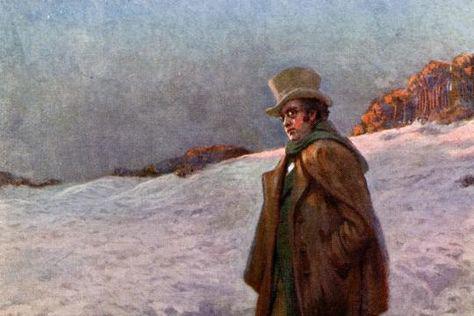
Franz Schubert’s Spiritual ‘Sehnsucht’
According to the Cambridge dictionary, the German word Sehnsucht can be translated as “craving, desire, longing, pining, wistfulness, yearning.”, with the second syllabe ‘Sucht’ meaning addiction: the addiction to yearn and desire.
Franz Schubert’s life and music are a complex experience of Sehnsucht, starting in his twenty-sixth year when he contracted an illness which inspired the melancholy moods that increasingly dominated his music. Although Schubert was surrounded by acquaintances and colleagues (artists and students) who attended his impromptu piano playing sessions, very few of his compositions from his incredibly creative and prolific work (chamber music, lieder, liturgical music, sonatas, symphonies) were performed during his lifetime. This lack of recognition for his skills and talents, combined with his heavy drinking, introversion, and his several unrequited loves, contributed, along with his illness, to a deepening depression and a tragic early death. Schubert himself said, “I am the most unhappy and miserable person in this world… my health will never improve, and in such despair, things will only become worse instead of better…” As has been the case with many geniuses throughout world history, Schubert was appreciated much more after his death. Schumann said “Schubert is Novalis and Hoffmann expressed in sound.” Liszt named Schubert “the most poetic musician who has ever lived.”
Although Schubert never traveled outside of Austria and Germany, there are images of drifting restlessness and watery voyages in Schubert’s chamber music (particularly the Trout Quintet), his Lieder (especially Die Schöne Müllerin), his solo piano pieces, and his final two symphonies. Schubert’s Fantasie in C major (“Wanderer Fantasy”) is one of the clearest expressions of Schubert’s yearning to travel far from his home to other places. The opening allegro section features prominently in a scene from François Truffaut’s 1960 noir Nouvelle Vague film Shoot the Piano Player. The main character Charlie a.k.a. Edouard Saroyan (played by iconic French singer Charles Aznavour) enters a studio as a young woman exits after her audition. The black-and-white cinematography of Raoul Coutard follows this young woman (her empty face indifferent to Paris surrounding her) as she walks away from the building. What is she feeling? Where is she going? The young woman leaves the scene and never returns.
There is an atmosphere of disappearances and vanishings within the adagio second section of Schubert’s Wanderer Fantasy. The adagio in C-sharp minor shares a spiritual kinship with Caspar David Friedrich’s 1818 painting Wanderer Above the Sea of Fog. Maurizio Pollini’s 1974 recording is the most masterful. The listener feels the philosophical, somber solitude of the wanderer as he climbs through the misty mountains. The music alternates between a resigned, slow struggle and a turbulent, windy wonder.
In 1824, at the age of twenty-seven, one year after the illness began to make his delicate health plummet, Schubert composed the string quartet in D minor, Death and the Maiden, in an attempt to confront his own mortality. The final section is a cacophonous and chaotic danse macabre, a descent into the dark depths – the two violins, the viola, and the cello swirl around the listener’s ears, skeletons summoning the doomed soul into the abyss, into oblivion. The most remarkable recording is by the Amadeus Quartet. Perhaps this is because three of the members (Siegmund Nissel, Peter Schidlof, Norbert Brainin) were Jewish and had escaped Hitler’s Holocaust.
Schubert’s music constantly swings like a sublime pendulum between despair and ecstasy – both pervaded with his Sehnsucht. Although Schubert composed masses, as James McCarthy noted in his article for Gramophone “Schubert’s Final Year,” Schubert “evidently distrusted a Church that reserved salvation for its adherents alone” and so he omitted the commitment to the Church from his masses. He also omitted the “resurrection of the dead” from his masses. As McCarthy observes in this same article, Schubert “embraced elements of pantheism… at times he tended towards agnosticism.” This pantheism was influenced by other German Romantics, such as Goethe, Novalis, and Schelling.
Although Schubert was not religious in a traditional sense, in 1825 during a rare time when his illness had subsided and he longed for a light at the end of the tunnel, Schubert composed one of the most beloved spiritual songs of all time: his “Ave Maria”. In 1972, the Russian animator Ivan Ivanov-Vano, inspired both by Schubert’s eternal, infinite plea to end the world’s suffering and by the contemporary atrocities in Vietnam, directed a haunting cinematic poem concerning the inhumanity of war.
Schubert’s music, more than any other classical composer, speaks of serene spirituality (rather than bombastic patriotism like Beethoven and Wagner) during times of war. As tenor singer Ian Bostridge perspicaciously noted in his 2015 book Schubert’s Winter Journey: Anatomy of an Obsession, “Schubert songs may have mediated German triumphs and German disasters over that whole troubling period from 1813 – the birth of modern German nationalism – to 1945, its ultimate shame and catastrophe” (81). One of the most powerful singers of the twentieth century, Dietrich Fischer-Dieskau, gave his first performance of Winterreise on January 30, 1943, during a British bombardment of Zehlendorf.
Gramophone published a list “The 50 Greatest Schubert Recordings” in 2019 and the last recording on the list is, in my opinion, not only the greatest Schubert recording, but some of the most deeply haunting music of all time: Dietrich Fischer Dieskau’s baritone vocals and Jorg Demus’ piano on their 1966 recording of Winterreise.
Schubert composed Winterreise in 1827 at the age of thirty. The first part of Winterreise was published in January 1828. Schubert was preparing the second part when he died at the young age of only thirty-one years old on November 19, 1828. The second part of Winterreise was published in December 1828.
Also during this last year of his life, Schubert composed his String Quintet in C Major. The adagio section (Schubert always displays the most depth and profundity in his adagios) was, according to James McCarthy, “the music Thomas Mann most wanted to hear on his deathbed.”
Although Winterreise is a song cycle set during the bleakest winter, the song “Der Lindenbaum” (“The Linden Tree”) is nostalgic wistfulness. “Der Lindenbaum” is E major – home, love, the months of May and June. It is also, as Thomas Mann says of his character Hans Castorp’s relationship with the song in The Magic Mountain, a call to death. Hans Castorp is singing Schubert’s song during the climax of this epic novel as he disappears into the trenches of World War I.
During “Das Wirtshaus” (“The Inn”), perhaps the most deeply emotionally moving song of Winterreise, the listener and the wanderer enter a cemetery to try to finally find rest. However, the graveyard turns the listener and wanderer away into the ice and snow. The key is F major, the green and pastoral key. In “Das Wirtshaus,” it is the funeral key.
The closer is an eerie epitaph for Franz Schubert. “Der Leiermann” (“The Hurdy Gurdy Man”) is deeply haunting. The key is A minor, the key of cold moonlight. The barefoot beggar, forgotten, plays his hurdy gurdy and staggers on the outskirts at the edge of the village as the dogs snarl and the north wind howls. The last lines are ghostly: “Strange old man/Shall I go with you?”
by Mark Lager

Beautiful music and article.
Thank You Janne.
I hope you keep doing pieces like this. Nice read about something I know little about but now want to. I’ll be looking for the next one.
Thank You Kevin.
Very informative and perfect with all the sound clips – thank you!
Thank You Marion.
This article should be the starting point for people who wants to get inside Schubert’s music.”Winterreise” is a masterpiece, I’ve listened to that beautiful song cycle since I was a child. It’s true, Schubert’s life experiences are portrayed inside his music, it is (indeed) an spiritual journey.
I saw Truffaut’s “Shoot The Piano Player” just right after the masterful “The 400 Blows”(future VW article for that film) . That opening allegro scene resembles the young woman feelings. I’m surprised with your musical knowledge, Mark. You pay a lot of attention to small details that make the difference to get into an specific conclusion. And there it is; early lack of recognition, heavy drinking, introversion, an uprising disease: A perverse combination.
Thank you, Mark!.
Octavio,
That’s remarkable to me that you listened to Winterreise as a child since it is such a bleak, dark, haunting song cycle. I first discovered it as a teenager when I first entered college. Thank You so much for your Schubert thoughts.
Vinylwriters is clearly the most exciting and interesting read being published today. Everything from Franz Schubert to Turkish arabesque. All done with style, class and respect for the music. This story is doing the work that the mainstream media no longer does. That is, offering something special for people who love music. The sound samples are great. They really make the story flow. Mark, your writing is amazing and a treat for VW readers. Thank you.
Thanks so much Shawn. I enjoy your writing, too. I especially appreciate both your experimental narratives that you often spin and that you’re always writing about music that is more obscure and off the beaten path.
It is a surprise and worth commenting to see such a beautiful piece about Schubert on here! Schubert achieved an almost untouchable compositional mastery within the cycle. Almost two thirds of all songs are in minor. But even the songs that are in moll cannot avoid harboring sad, desperate elements. Your review captures this well.
For me, “Winterreise” is the greatest thing that has ever been written in classical musical literature.
Arnold,
I agree with your reflections about Winterreise. Schubert was underrated during his own lifetime and is still so underrated within our era. I much prefer Schubert to Bach, Beethoven, Schubert. It is because Schubert’s music feels so much more sensitive, more spiritual, and subtler than Bach, Beethoven, Mozart.
Schubert will always be my favorite classical composer.
You’re taking the reader on a lovely journey, Mark. Loved to read about the German cultural contexts, Goethe, Thomas Mann (whose brother Heinrich I much prefer), and loved the Russian animation to ‘Ave Maria’
Thank you for the beautiful read